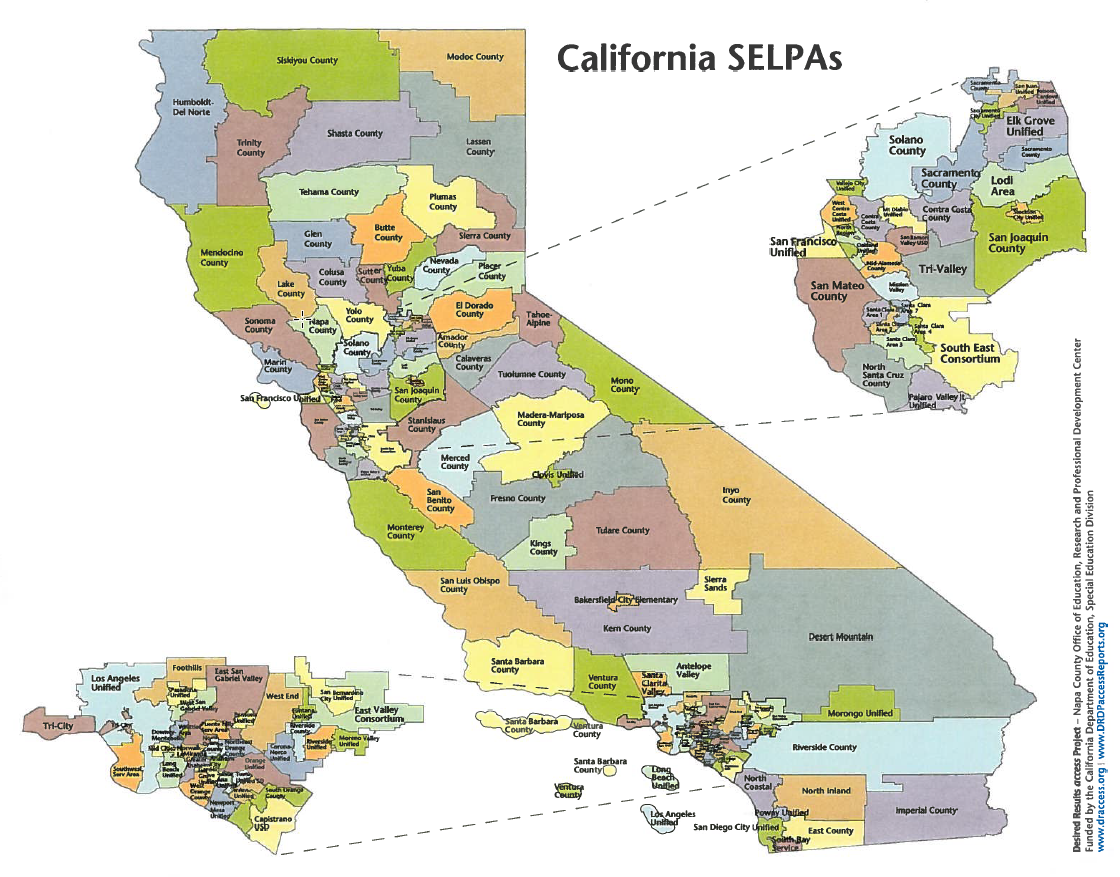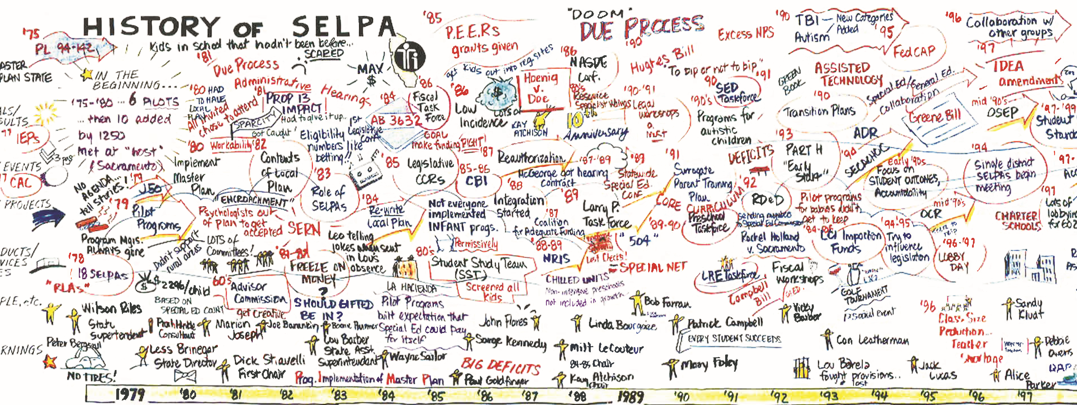The Formation of SELPAs
Master Plan for Special Education
In 1974, the California State Board of Education (SBE) adopted a Master Plan for Special Education based on the principle that “education is for all children, regardless of differences in abilities.” The Master Plan was designed to correct identified weaknesses in California’s special education system. The previous system of support did not adequately address the diversity of incidence, the total number of individuals with exceptional needs, problems associated with being a small local educational agency (LEA), the need for program flexibility to meet local needs, and issues related to funding requirements. Additionally, it did not include a logical data collection and reporting system. As a result of the identified shortfalls, the Master Plan addressed (among other things), the need for:
- A cleaner delineation of responsibility for the provision of special education at the state, county, and local level.
- Coordinated improvements related to special class programs offered by LEAs, county superintendents of schools, state, and private schools.
- A system to collect information and properly evaluate special education programs.
- An equitable system of financial support for special education which promotes improved programs and fiscal accountability.
In short, there was an overall need to clearly delineate the responsibilities of LEAs for providing special education and ensuring full accountability. The Master Plan also established levels of responsibilities to eliminate duplication of duties and specify the responsibilities of the SBE and the State Superintendent of Public Instruction (SSPI) regarding local plans. It initiated the idea and creation of local accountability agencies.
Establishing Special Education Local Accountability
Under California’s original system of special education categorical programs, large LEAs generally provided direct services for their students with disabilities (SWD), whereas county offices of education (COEs) generally served students on behalf of smaller LEAs. This bifurcated system of responsibilities recognized a longstanding concern that smaller LEAs lacked the resources to provide a full array of services to SWD.
In 1974, Assembly Bill 4040 was signed into law, a measure to pilot the Master Plan for Special Education in no more than 10 Responsible Local Agencies (RLAs) during fiscal years 1975–76, 1976–77, and 1977–78.
In 1977, AB 1250 was enacted for the purpose of expanding the Master Plan for Special Education beyond the 10 pilot agencies, phasing in the new plan statewide. California’s Master Plan for Special Education addressed previous concerns by requiring all LEAs to join RLAs, each of which was responsible for coordinating special education among its member LEAs. A large district could be its own RLA, whereas smaller LEAs were required to partner with neighboring LEAs and/or COEs to form a collaborative RLA. AB 1250 revised the role of RLAs to include receiving and distributing funds pursuant to comprehensive local plans, providing sufficient administrative support, and coordinating the administration of the plan. The role of the COE was also revised to include the added responsibility of receiving and approving or disapproving comprehensive local plans based on the ability of the plan to assure special education services were provided to all SWD.
In 1982, Senate Bill 1870 repealed all prior categorical special education program provisions according to disability type and restructured the state’s special education program as set forth in the Master Plan, and provided a new funding model for special education. The Master Plan would no longer be funded on a per-child basis, as it had been. Instead, it was to be funded on a service-based model. RLAs were renamed to SELPAs. A SELPA was defined as the service area covered by a comprehensive local plan of sufficient size and scope, under standards adopted by the local board, in conjunction with one or more districts, who through joint powers agreements or other contractual agreements, includes a governance structure and necessary administrative support to implement a local plan. Approved SELPAs must have a system in place designed for determining the responsibility of participating agencies for the education of individuals with exceptional needs residing in the SELPA.
The complexity of special education rules and responsibilities warranted a need for skilled and knowledgeable SELPA administrators who understood special education laws and regulations and applied them fairly. This led to what we today hold SELPA Administrators responsible for assuring, specifically that:
- All individuals with disabilities receive a free appropriate public education (FAPE) in the least restrictive environment (LRE).
- All regular (general) education resources are considered and, where appropriate, utilized on a local or regional basis to meet the needs of SWD.
- A system exists at the regional level for the identification, assessment, and placement of SWD.
- A viable system for public education is functioning in the community, with broad participation and interaction involving parents and other agencies serving children and young adults.
- An annual compliance monitoring system is implemented, and continues to assure items found to be noncompliant through the California Department of Education (CDE) Quality Assurance process are promptly corrected in accordance with law.
Current Makeup of California Special Education Local Plan Areas
California currently has 136 SELPAs, configured in a variety of ways including single school LEAs, several LEAs, one or more counties, a combination of LEAs and counties, composed solely of charter schools, a combination of LEAs and charter schools, and COEs. At their inception, SELPAs were approved based on criteria of meeting sufficient size and scope and the ability to provide the full array of instructional programs, related services, and placement options necessary to meet the educational needs of their students with exceptional needs as specified in law. Such programs and services must be clearly identified in each SELPA’s local plan.
Size and Scope Requirements for Creation of New SELPAs
Size and Scope of Special Education Local Plan Areas are described on the CDE Size and Scope web page at https://www.cde.ca.gov/sp/se/lr/szscpselpa.asp.
Special Education Local Plan Area Regionalization Models, California State Board of Education, January 2010 Agenda, Item 32, at https://www.cde.ca.gov/be/ag/ag/yr10/documents/jan10item32.doc. (6 pages)
Special Education Local Plan Area Regionalization Plan Flow Chart, California State Board of Education, January 2010 Agenda, Item 32, Attachment 1, at https://www.cde.ca.gov/be/ag/ag/yr10/documents/jan10item32a1.doc. (1 page)
California State Board of Education Special Education Local Plan Area Size and Scope Requirements, California State Board of Education, January 2010 Agenda, Item 32, Special Education Local Plan Area Size and Scope Requirements, Attachment 2, at https://www.cde.ca.gov/be/ag/ag/yr10/documents/jan10item32a2.doc. (2 pages)
[Source for the above: CDE Memo to SBE, "Special Education Local Plan Areas - History and Requirements," March 27, 2019.]

